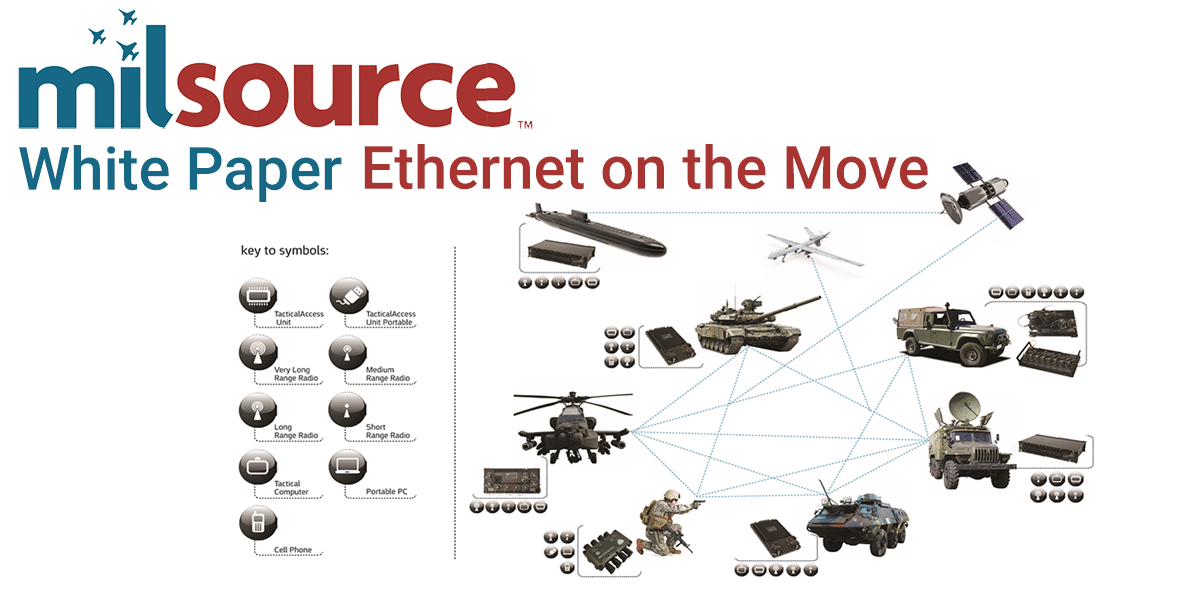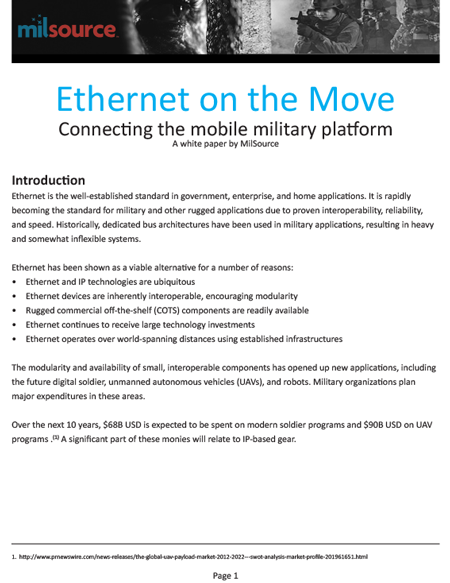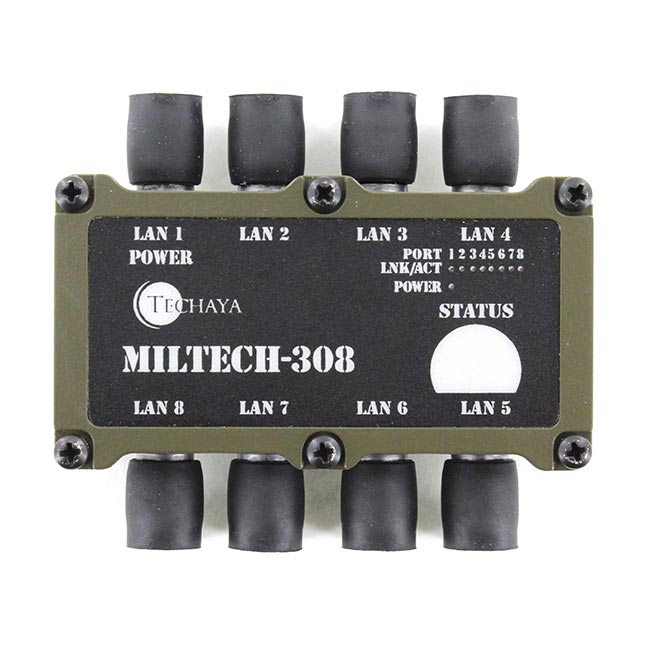Ethernet is the well-established standard in government, enterprise, and home applications. It is rapidly becoming the standard for military and other rugged applications due to proven interoperability, reliability, and speed. Historically, dedicated bus architectures have been used in military applications, resulting in heavy and somewhat inflexible systems.
Ethernet has been shown as a viable alternative for a number of reasons:
- • Ethernet and IP technologies are ubiquitous
- • Ethernet devices are inherently interoperable, encouraging modularity
- • Rugged commercial off-the-shelf (COTS) components are readily available
- • Ethernet continues to receive large technology investments
- • Ethernet operates over world-spanning distances using established infrastructures
The modularity and availability of small, interoperable components has opened up new applications, including the future digital soldier, unmanned autonomous vehicles (UAVs), and robots. Military organizations plan major expenditures in these areas. Over the next 10 years, $68B USD is expected to be spent on modern soldier programs and $90B USD on UAV programs .(1) A significant part of these monies will relate to IP-based gear.
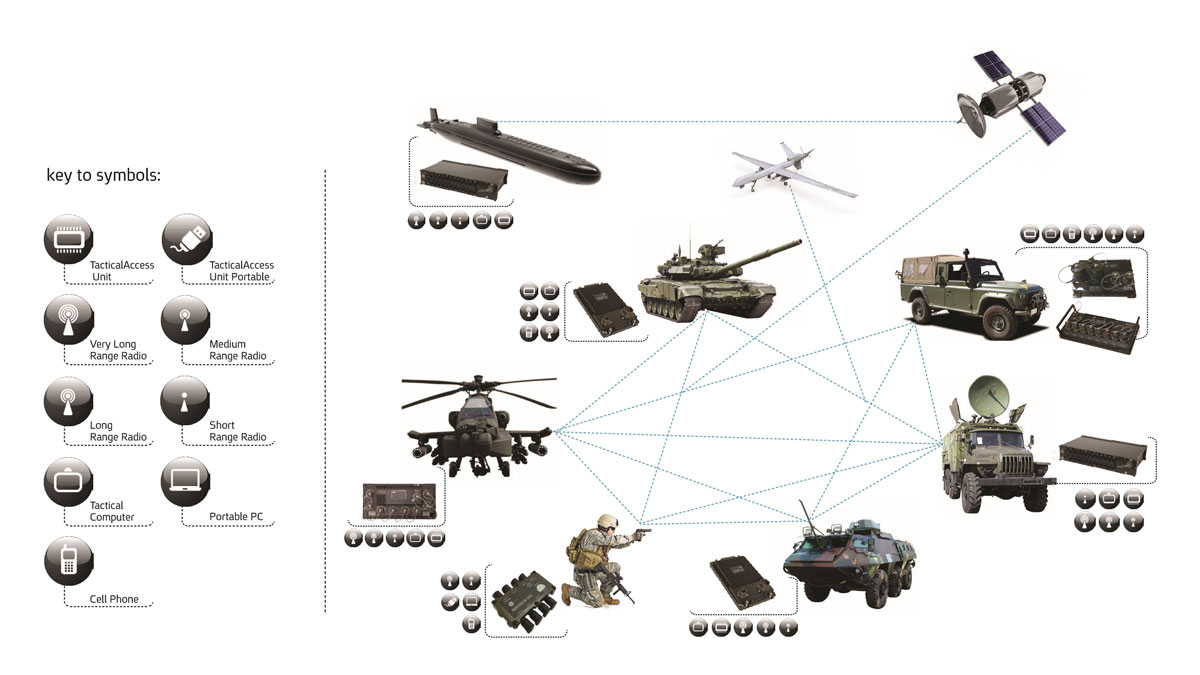
Figure 1 depicts some of the anticipated Ethernet requirements in a number of military platforms. An important concern in this deployment of IP-based technology is connectivity: how will the growing number of devices talk to each other in a way that enhances performance, portability, and reliability.
In this white paper we will investigate the growing use of Ethernet-based devices in these applications:
- • The Future Digital Soldier
- • Unmanned areial vehicles (UAVs)
- • Unmanned ground vehicles (UGVs)
- • Unmanned underwater vehicles (UUVs)
The Future Digital Soldier
Military organizations around the world are planning and implementing the next generation of digitally-armed soldiers. The US Army’s RDECOM division is overseeing the development and delivery of Digital Soldier capabilities that empower, unburden and protect warfighters. Digital Soldiers are enabled by a suite of networked sensors, wearable computing and display devices, data fusion and decision support tools powered by machine learning and enhanced soldier and small unit training. Other capabilities will include enhanced capabilities for manned/unmanned teaming, sensor protection and and sensors for monitoring with biofeedback to improve soldier cognitive and physical performance.
Future soldier capabilities targeted for 2025 include low light level sensors, augmented reality, integration of soldier worn devices via NGH and ISW, lightweight wearable power/energy sources, advanced target detection, red/blue force tracking, route tracking and hostile fire detection’s.
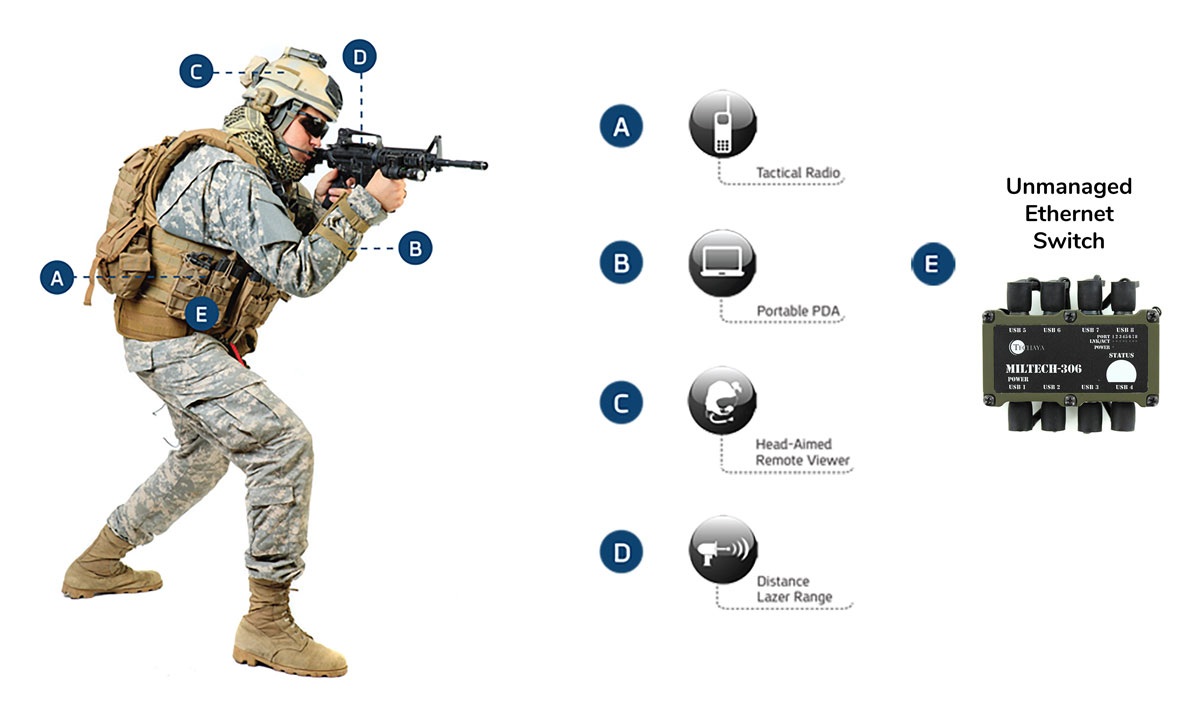
A future soldier will be fully equipped with advanced weapon and communication systems including exoskeletons. Figure 2 shows some of the high-tech devices are already worn in combat.
These systems are intended to enhance soldiers’ survival and effectiveness by augmenting command and control (C&C), lethality, mobility, and sustainability. The soldier will continue to generate and receive more and more data, establishing a single information environment through the transparent flow of information. Even today, field trials are being deployed with the IP-based devices, principally on the head and torso, which include:
- • An end-user device (EUD) that combines helmet-mounted heads-up display, ruggedized keyboard, computer, navigation devices, GPS, and associated batteries and cables.
- • A man-packable radio to send and receive information and voice data.
- • Communications systems that convert between RF and IP, including terrestrial radio, satellite communications, and Wi-Fi. A soldier may become an ad-hoc Wi-Fi node in a mesh network.
- • A system power source and support equipment.
Regardless of the hardware used, wired Ethernet is the key component that ties everything together. Every ounce and inch on a soldier is critical to their survivability. Tying Ethernet components together with a minimum of weight and minimal power requirements is essential.
UAVs and other Autonomous Vehicles
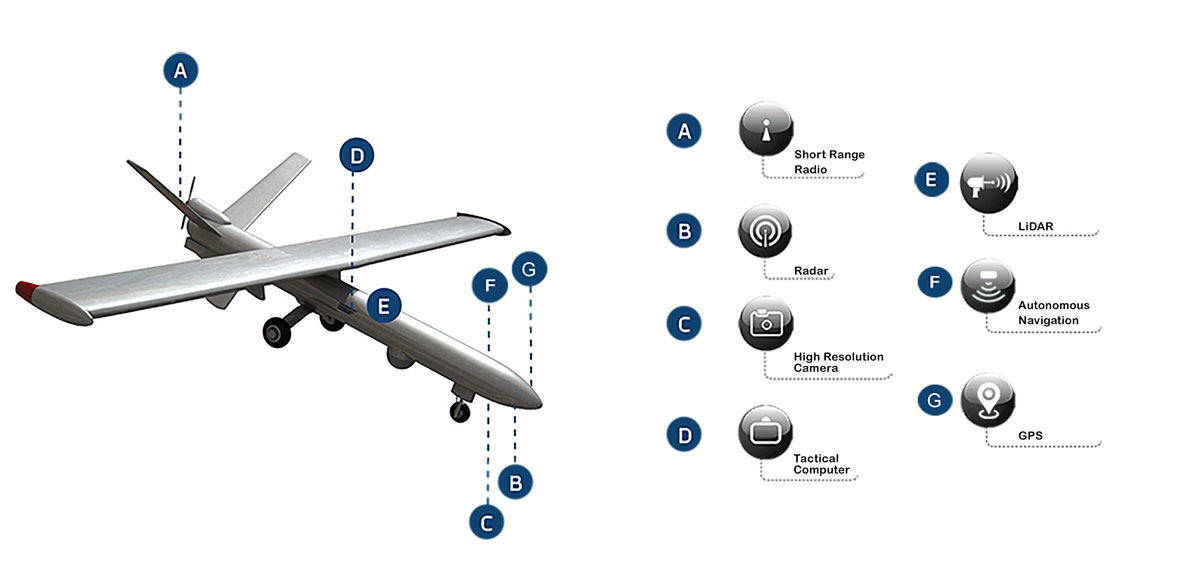
Both fixed- and rotary-wing UAVs are used extensively in the military for reconnaissance and assault and for a wide variety of commercial applications. Compared to a soldier, UAVs carry an enormous amount of electronic equipment.
Several advanced UAV platforms are under development and will see service in the next several years. The Northrop Grumman X-47B, for example, was the first UAV to be launched off of aircraft carriers. The US Marine Corps Warfighting Lab has successfully tested the ability to have a single Marine operate six drones in the air simultaneously. The highly anticipated Northrup Grumman B-21 Raider Long Range Strike Bomber is said to be designed to have future capabilities to replace current conventional piloted stealth bombers with unmanned versions. (2)
UAVs have seen a growing use in law enforcement, fire and road patrol, anti-piracy, search and rescue, border patrol, counter terrorism, and to combat drug smuggling. Commercial uses abound, often substituting for fixed wing aircraft: UAVs can go where it would be too dangerous to send a pilot – near the ocean’s surface during a hurricane, for example. With additional sensors, they can be used to monitor livestock, determine plant ripeness, and find areas for oil and gas exploration. The Raytheon Coyote is one such example where
Raytheon calls out that a single airframe can be fitted for various payloads to execute missions in counter-UAS, surveillance or hurricane hunting. UAVs can also stay on duty for extended periods of time since remote pilots can be rotated to eliminate fatigue normally associated with long-haul flight assignments.
An increasing number of these components are being replaced with modular elements connected via Ethernet. The next generation Global Hawk UAV, for example, will use an all modular set of elements connected through fiber optics and using IPv6. IPv6 will allow data to be directly forwarded to its destination without reformatting.
While payloads may differ for each application, all these systems have common elements which must interconnect for flawless operation in the absence of a human operator. Each device must communicate with a centralized compute platform and traffic is often consolidated and transmitted via satellite back to a command station. The key challenge is packing all these elements in a compact, lightweight package that operated flawlessly even after hundreds of hours of operation.
Unmanned Ground Vehicles
Robots have long been an essential component of industrial production and domestic law enforcement. They are now making an appearance on the battlefield as unmanned ground vehicles and several categories will require support for Ethernet connections:
- • Lightweight tracked robots – with numerous military and law enforcement applications including ordinance disposal, surveillance of small places, direct fire object breaching, hazmat detection and more.
- • Mediumweight vehicles—cover several applications, many of them to assist or replace soldiers as they perform critical or hazardous tasks currently performed by war fighters. The Titan is a fully modular, hybrid unmanned ground vehicle (UGV) developed jointly by Milrem and QinetiQ North America (QNA). preferred by the US Army for Phase 1 evaluation of the Squad Maneuver Equipment Transport (SMET) program. The open architecture allows for multiple payload variations that can assist in anything from earth-moving blade / bucket, casualty evacuation (CASEVAC) litter racks, logistics support basket and other more defensive applications.

- • Heavyweight vehicles—are being developed to help keep soldiers out of harm’s way. Some of these applications include mine clearing, bull dozers, autonomous tanks and more. Some of these programs include the Abrams Panther which detects and clears mines using mine rollers or mine ploughs. It can clear a 4.6 2 minefield in about an hour—which is much safer and faster that human engineers with handheld detectors. Large tanks and bulldozers are being retrofitted with autonomous controls. Examples include the ASI Robotic Dozer and several projects are under development at TARDEC’s Warren, Michigan facility.

In order to operate in an unmanned state these platforms must have a sophisticated network of sensors, cameras, day/night infrared (IR), thermal imaging, microphone and radio systems, and various other command and control devices. In all instances, these new, sophisticated platforms must be able to operate flawlessly in harsh environments.
Unmanned Underwater Vehicles
Unmanned underwater vehicles (UUV), sometimes known as underwater drones, are any vehicles that are able to operate underwater without a human occupant. These vehicles may be divided into two categories; remotely operated underwater vehicles (ROVs), which are controlled by a remote human operator, and autonomous underwater vehicles (AUVs), which operate independently of direct human input. Current military applications include; underwater mine detection, ship hull inspection, nuclear reactor decontamination, payload delivery and more. Commercial and scientific applications include underwater exploration, search and rescue, pipeline inspection and innumerable other applications.
Because of the obvious interference that water may have on distorting transmissions and the obstacles that underwater exploration may produce; unmanned vehicles have been developed as both tethered and remotely managed platforms. In either configuration, these platforms will have several sensors, most likely cameras, and possibly data recorders that must all communicate with each other and a centralized compute platform. In all probable instances, size and weight are key design factors along with the fact that each component must be hardened to be able to stand up to shock, vibration and the corrosive effects of salt water.
The Need for Small, yet Sophisticated Switching
The growing number of Ethernet-based devices supporting these mobile applications must be connected to the mission computer, and often to each other; Ethernet switches are the common means of making such connections. Although we have primarily discussed future soldier, UAV, UGV, UUV, and Ethernet switches are needed throughout the military infrastructure, as we referenced initially in Figure 1. A wide range of Ethernet switches are needed to support these next-generation military and commercial mobile platforms.
Unmanaged switches connect devices at the most basic level. They are pre-configured at the factory and allow multiple devices to pass data packets back and forth to each other without programming. They are perfect for “plug and play” type applications or where simplicity is paramount. (i.e.: digital soldier).
Managed switches, on the other hand, are the solution for scenarios that involve more devices, or require redundancy, monitoring, and control over the network. Managed switches are remotely programmable via Web or programmatic interfaces to allow pre- and dynamic configuration. These switches provide key features to support today’s applications; primary among these are quality of service, VLANs, spanning tree, and redundancy.
Each application that uses an Ethernet network has inherent requirements for its proper operation. Digitized audio (voice over IP – VoIP) connections require very little bandwidth but are sensitive to delay – called latency- and to the variation in delay–called jitter. Video connections are likewise sensitive to latency and jitter and can use significant bandwidth. Tactical and targeting displays use varying amounts of bandwidth, but must also remain close to “real-time” to be useful. Each application requests that the network provide it with a certain quality of service (QoS) by setting values in the network packet headers. Managed switches then implement constraints that prioritized traffic with higher QoS settings.
VLANs are a means by which applications, sets of applications, or sets of devices create a virtual private local area network (VLAN) that logically segregates their network traffic from other VLANs. Switches can restrict inter-VLAN traffic and even provide different levels of QoS to VLANs.
Multiple switches can be used to provide redundancy and to eliminate the possibility of a single point of network failure. The switches are interconnected so that the failure of a switch or link between switches can be automatically rerouted.
Switches use spanning tree and other algorithms to implement redundant paths and sometimes balance network traffic.
For a period of time, until all mobile electronics are Ethernet-based, other wired communications technologies will continue to be used: USB and serial communications among them. COTS switches are available with all these capabilities, but they are not rugged enough, require AC power, are too large, and weigh too much. Where every square inch of space, every ounce of weight, and every watt of power is critical, what’s needed is a rugged, small, light, power-efficient switch that supports sophisticated switching applications.
Techaya
Techaya is a prime developer, innovator and manufacturer of military rugged and tailor-made IP-based communications solutions. Each of their MILTECH Ethernet switches, USB hubs and media converters is designed and manufactured purpose-built for military applications.
The MILTECH series includes:
- • MILTECH 904 – 4-port managed Gigabit Ethernet (10/100/1000) switch
- • MILTECH 907 – 5-port managed Gigabit Ethernet (10/100/1000) switch
- • MILTECH 918 – 8-port managed Gigabit Ethernet (10/100/1000) switch
- • MILTECH 919– 8-port managed Gigabit Ethernet (10/100/1000) switch on board
- • MILTECH 304 – 4-port unmanaged Fast Ethernet (10/100Mbps) switch
- • MILTECH 308 – 8-port unmanaged Fast Ethernet (10/100Mbps) switch
- • MILTECH 309 – 8-port unmanaged Fast Ethernet (10/100Mbps) switch on board
- • MILTECH 300 – 5+1-port USB 3.1 hub on board
- • MILTECH 303 – 5+1-port USB 3.1 hub
- • MILTECH 306 – 7+1-port USB hub
- • MILTECH 402 – 5 port Fast Ethernet switch with POE and external power distribution
- • MILTECH 406 – Communications grid solution with Ethernet, USB, serial and SMBus communications
Each MILTECH product is a rugged, hardened, military-grade device that meet major MIL STDs, including:
- • MIL-STD-461E – Electromagnetic resistance (EMI)
- • MIL-STD-810F/GM – Environmental protection (temperature, rain, sand, salt, dust, etc.)
- • MIL-STD-1275 and MIL-STD-704 – Power protection against transient, surge, spike, ripple,
and other power disturbances - • IP67/IP68 – Solid particle and water protection, immersion up to 1m+
Conclusion
Driven by rapid advancement and lower costs, Ethernet is becoming the standard for connecting the IP-based components of the future soldier and in autonomous vehicles. These rugged components need to be connected with equally reliable, purpose-built Ethernet switches. The growing sophistication of the components demands equally sophisticated switch features. The Techaya MILTECH line of switches is the perfect solution for these and other mobile requirements.
Download the WhitePaper Here
1. http://www.prnewswire.com/news-releases/the-global-uav-payload-market-2012-2022—swot-analysis-market-profile-201961651.html
2. http://www.thedrive.com/the-war-zone/15902/document-confirms-b-21-to-be-delivered-optionally-manned-and-nuclear-capable

